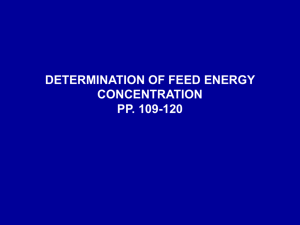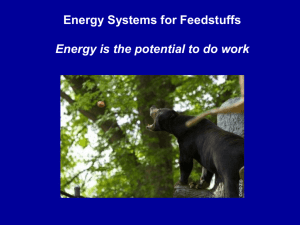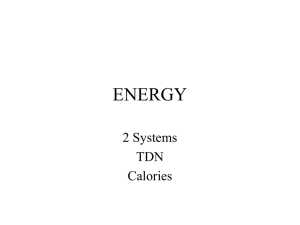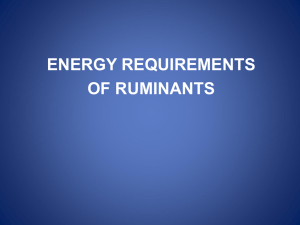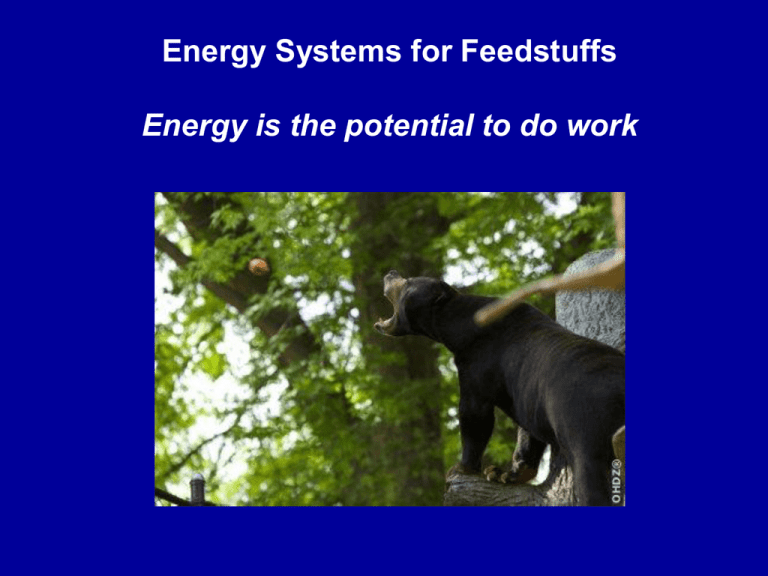
Energy Systems for Feedstuffs
Energy is the potential to do work
•
•
•
•
Calorie (c)
Kilocalorie (kcal)
Joule (J)
Total Digestible
Nutrients (TDN)
•
•
•
•
Gross energy (GE)
Digestible energy (DE)
Net Energy (NE)
Metabolizable Energy
(ME)
Definitions
– Calorie (cal)
• Amount of heat required to increase the temperature of 1 g of
water from 14.5 to 15.5oC
– Kilocalorie (kcal) = 1000 cal
– Megacalorie (Mcal) = 1000 kcal = 1,000,000 cal
Determine Feed Energy Value
• Total Digestible Nutrients (TDN)
• Partitioning of Feedstuff Energy
• Roughage / Concentrate Ratio
TOTAL DIGESTIBLE NUTRIENTS (TDN)
• Traditional system to express digestible energy
concentration of feedstuffs
• Basis of TDN are physiological fuel values
Nutrient
Heat of
combustion,
kcal/g
Heat of
combustion of
metabolic
products,
kcal/g
Nutrient
absorption, %
Physiological
fuel value,
kcal/g
Carbohydrates
4.1
-
98
4.0
Fats
9.45
-
95
9.0
Protein
5.65
1.30
92
4.0
•
Determining TDN
– Conduct a digestibility trial and determine the apparent digestion coefficient of:
• Crude protein
• Crude fiber
• Nitrogen free extract
• Ether extract
– Calculate concentration of each digestible nutrient
– Using all Dry Matter Basis
•
•
•
•
Digestible protein (DP) = CP x CP dig. %
Digestible crude fiber (DCF) = CF x CF dig. %
Digestible NFE (DNFE) = NFE x NFE dig. %
Digestible EE (DEE) = EE x EE dig. % x 2.25
– Calculate TDN
• TDN, %DM = %DP + %DCF + %DNFE + (2.25 x %DEE)
• Expressed as a % of the ration OR in units of weight (Lb, kg, etc…)
• Conversion:
• 1 Lb TDN = 2,000 Kcal digestible energy
•
1 Kg TDN =
Kcal digestible energy
Limitations of TDN
– Limitations associated with digestion trials
• Errors in chemical analyses
• Errors in sample collections
– Low feed intake increases digestibility
– DMI at 3x maintenance reduces TDN by 8%
– Does not include all energy losses in metabolism
• Does not include urine losses
• Does not include methane gas losses
– End product of rumen fermentation
– 3 – 10% of feed energy
• Does not include:
– Work of digestion
– Heat of fermentation
– Heat of nutrient metabolism
Heat increment
– Overestimates the usable energy value of feeds
• Particularly of forages
Energy Partitioning
Gross Energy (GE)
Fecal energy loss (FE)
Digestible Energy (DE)
Metabolizable Energy (ME)
Net Energy (NE)
Maintenance (NEm)
Urine (UE) and gas products of
digestion (GPD)
Heat Increment (HI)
• Fermentation
• Digestion
• Metabolism
Production (NEp)
GROSS ENERGY (GE)
• Total potential energy of the feedstuff
• Measure by bomb calorimeter
– Burn until completely oxidized
– Measure amount of heat released
• Fats > Proteins > Carbohydrates
– Average ratio 2.5 - 1.7 - 1.0
• Water and Ash have no energy
• GE doesn’t differentiate between availability of energy
– Little correlation between GE and usefulness to animal
• Corn grain- 4.5 kcal/g
• Oat straw- 4.7 kcal/g
DIGESTIBLE ENERGY (DE)
Digestible Energy
• Gross Energy - Fecal losses
– Fecal Losses
• Ruminants > Monogastrics
• Ruminants-
– Can be as great as 60% in low quality forage diets
• Monogastrics-
– Digestibility of energy increases slightly as body weight increases
• Cannot be used to express energy requirements of poultry
(or reptiles)
• Relation to Total Digestible Nutrients
– 1 lbs. TDN = 2000 Kcal DE
– 1 kg TDN = 4400 Kcal DE
METABOLIZABLE ENERGY (ME)
• ME = DE – (Gas + Urinary Energy)
– Must be calculated in a neutral growth animal
• Zero nitrogen balance
• Protein stored or lost from muscle will distort values
– Urine (Urea) ~ 5% of GE
• Lost as a result of protein metabolism
• Ruminants>Monogastrics
– Combustible gases
• Ruminants >>> Monogastrics
– Primarily lost as CH4 ~ 3-10% of GE
– Monogastric losses are small and usually ignored ~ 0.13.0% of DE
Metabolizable Energy (ME) cont
• Commonly used in poultry, swine, companion animal
formulations
• Relation to DE
– Ruminants
• ME, kcal/kg = DE x 0.82
– Swine
• ME, kcal/kg = DE x (1.012 - (0.0019 * Protein%))
• May overestimate energy value of byproduct feedstuffs
– Dogs
• ME (kcal) = DE – (1.04 x g protein)
• Works best for industry’s highly digestible diets
– Cats
• ME (kcal) = DE – (0.77 x g protein)
NET ENERGY (NE)
• The amount of energy that is completely useful to the animal
for maintenance, lactation, or growth
• NE = ME – HI
– Heat Increment- increase in heat lost because of the energy costs
of digestion and the metabolic processes
• Work of Digestion
– Activity, Chewing, & GI contractions
» As much as 30% of total heat lost in animals (ruminants)
» Low quality forage increases work of digestion
» Movement and excitement for meal
• Heat of fermentation
– Heat released by microbes during fermentation
» ~ 5-10 % of GE
» Low quality forage increases heat of fermentation
» Increased lipids decreases heat of fermentation
• Heat of Nutrient Metabolism
– ~10-30% of GE lost
– Heat increment:
• Contributes to thermal regulation in cold climate
• Contributes to heat load in warm climate
NEm REQUIREMENT
•
•
•
Maintenance requirement (zero gain or loss of energy from body tissues)
– The amount of feed energy needed for:
• Basal metabolic activities
• Body temperature regulation
• Physical activity:
Requirements:
– Beef cattle
• NEm = 0.077 Mcal/EBW0.75
– Dairy cattle
• NEm = 0.080 Mcal/EBW0.75
– Varies with weight, breed, age, sex, season, temperature, nutritional status,
physiological status
Significance in net energy calculations for growing animals
– Must always calculate the amount of feed necessary to maintain an animal
before calculating how much feed would remain or be needed to achieve a
given level of body weight gain
NEm DETERMINATION
• Calorimetry
– Animal placed in animal calorimeter
– ME intake and heat production measured
– NE, Mcal/kg = (ME intake – Heat production)/DMI
• Comparative slaughter
– Feed group a common diet for two weeks
– Slaughter a portion of a group of animals and grind carcass and
organs – determine energy on whole body (E1)
– Feed several levels of feed for a period of time
– Slaughter remainder on animals and grind carcass and organs –
determine energy on whole body (E2)
– Retained Energy (RE) = (E2 - E1)
– NE, Mcal/kg = RE/DMI (assumes a linear relationship)
– Use of NE for maintenance (NEm), body weight gain (NEg), or
lactation (NEl) determined by regression
Relationship to ME
Beef cattle (based on comparative slaughter)
NE (maintenance)= NEm = 1.37ME – 0.138ME2 + 0.0105ME3 - 1.12
NE (gain)
= NEg = 1.42ME – 0.174ME2 + 0.0122ME3 - 1.65
Swine
NE = 0.726 x ME + 1.33 x EE + 0.39 x Starch – 0.62 x CP – 0.83 x ADF
EFFICIENCY OF NE USE FOR
LACTATION
Energy balance
Lactation
+
Growth
0
Maintenance
_
Low
Energy in Diet
High
NET ENERGY FOR GAIN (NEg)
• Net energy remaining after maintenance
requirements are met
• Net energy is used less efficiently for gain than
for maintenance
EFFICIENCY OF NE USE FOR
LACTATION
Energy balance
Lactation
+
Growth
0
Maintenance
_
Low
Energy in Diet
High
• Significance of equal efficiency of energy use for
maintenance and lactation
– Net energy requirements for dairy cows can be
expressed with one value
• Net energy for lactation, Nel
– Energy requirement for lactation considers
• Amount of milk produced
• Fat percentage of milk produced
COMPARISON OF ENERGY FRACTIONS
IN DIFFERENT FEEDSTUFFS
Corn
grain
kcal/g
Alfalfa Hay
(midbloom)
kcal/g
Oat Straw
kcal/g
Gross Energy
4.5
--
4.7
Digest. Energy
3.92
2.56
2.21
Metab. Energy
3.25
2.10
1.81
NEm
2.24
1.28
0.97
NEg
1.55
0.68
0.42
• Energy in Beef Nutrition
– Predict weight gain
– Estimate intake for desired weight gain
– This week in lab:
NE requirements: Table 2-3 & 2-4, p 105 – 106
NE content: Table 2-5, p 106 - 107

